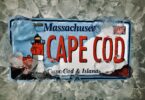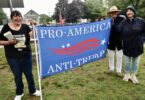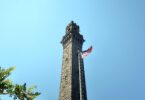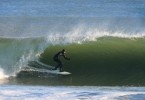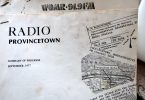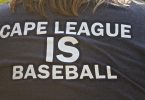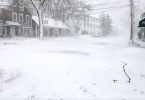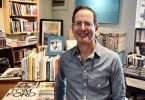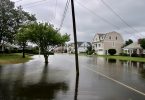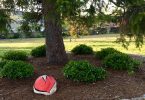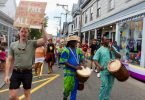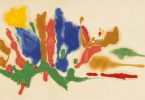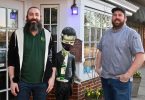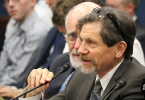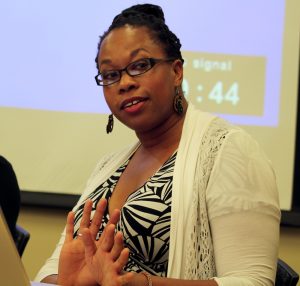
Stephanie Seales, assistant children’s librarian at Falmouth Public Library, speaks about the importance of diverse books.
FALMOUTH – Last week, in honor of Banned Books Week, Stephanie Seales, library assistant in the Children’s Room at Falmouth Public Library, put out a Hispanic Heritage display of books. It turns out books by authors of diverse backgrounds and ethnicities are among the most banned books. Seales said she had not noticed a lot of movement on the display.
Seales admitted there are not many Hispanic people in Falmouth, but that should not mean that people do not want to read books about Hispanic heritage.
“People need to be more intentional. It’s important for children,” Seales said.
She said of the books, “It’s the windows element,” referring to the windows and mirror philosophy of exposing children not just to “mirrors,” images they recognize as being like themselves, but also “windows,” which are images that show them a diverse world.
“I am Hispanic. I know there aren’t that many in Falmouth. Even if [parents] aren’t concerned about diversity here, their kids will go out into the world some day. Reading diverse books helps build empathy, so they see people as people, not as other.”
Seales was one of four women on a panel last week at Falmouth Public Library about the importance of promoting books by diverse authors as part of Banned Books Week.
Besides Seales, the panel included I.W. Gregorio, a surgeon and author of a new young adult book called, “None of the Above” about an 18-year-old who outwardly looks like a girl but has some male body parts; Amitha Knight, an unpublished author who has been active in the diverse books movement; and Sara Hines, co-owner of Eight Cousins Books in Falmouth.
Hines said the discrepancy that is being challenged is that 93% of children’s books have white protagonists and it is difficult to find books that feature characters who have diverse ethnicities.
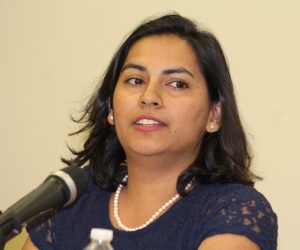
Amitha Knight, an Indian American who grew up in Arkansas, encourages audience members to “buy a book by an author that doesn’t look like you.”
The panel was presented by the Falmouth No Place for Hate committee, as well as the library and Eight Cousins.
“People fight bias and promote diversity through and advocacy and education,” said Pamela Rothstein of No Place for Hate, in introducing the panel.
The presentation continues on the #We Need Diverse Books movement that has arisen over the past few years to counter the publishing industry’s timid stance to books by authors of diverse ethnicities about people of diverse ethnicities.
“Basically, we’re trying to change the face of children’s publishing,” Knight said. She said the movement is trying to challenge the tendency for publishers to choose only books about white, straight people.
“Other voices matter,” Gregorio said.
Hines said that these days, the term banned books mostly refers to books that are “challenged” by libraries or school districts, meaning that someone tries to block the books from being acquired by questioning the appropriateness of the subject matter.
“It’s soft censorship,” Seales said.
Librarians can be fearful of bringing in books with certain subject matter, resulting in what Gregorio said, is an “insidious” version of censorship.
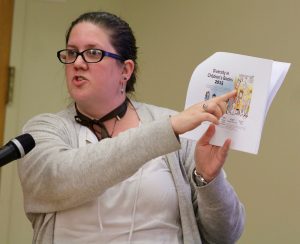
Sara Hines, co-owner of Eight Cousins Books in Falmouth, says statistics show nine of the top 10 challenged books last year had diverse content.
Hines said, “It’s more subtle and nuanced. Decisions can be made—everything up to an outright ban—to control critical voices.”
Books can be challenged by a parent, which statistics show is the primary entity to challenge books, representing 40% of the challenges. Challenges also come from patrons (27%), board or administration (10%), pressure group (6%), librarian or teacher (6%), government (4%) or other entity.
These challenges can have dire effects on a book’s distribution.
Hines presented the common reasons given for challenging books, such as homosexuality, a religious viewpoint, a political viewpoint, having sexually explicit content, violence, or nudity, among other reasons.
According to statistics, Hines said, nine of the top 10 challenged books have diverse content.
Of the 275 challenges recorded by the American Library Association’s Office for Intellectual Freedom, the 2015 Top Ten Most Challenged Books include “Fun Home”, “Fifty Shades of Grey”, and the Holy Bible.
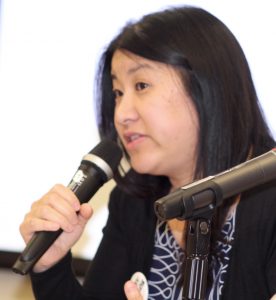
Author I.W. Gregorio has recently written a book called “None of the Above,” that has been optioned for television.
Gregorio, an Asian-American who grew up in central New York, said an earlier book she wrote was at first compared as being too similar to another book by an Asian American, as though all books by Asian Americans were in the same category.
Readers can challenge the scarcity of diverse books, Gregorio said, by actively seeking them out at libraries, bookstores and even directly to publishers.
Knight said that as an “Indian American girl who grew up in Arkansas,” she knows the importance of children seeing diverse books and so when a book buyer told her that her unpublished books is “a hard sell,” that buyer does not see that there are people who would benefit from reading a diverse point of view.
Seales said questioning the status quo can definitely make a difference. “It’s really important we’re all active and challenging people. That really does make a difference. It matters.”
Knight summed it up. “Buy a book by an author that doesn’t look like you,” she said.

